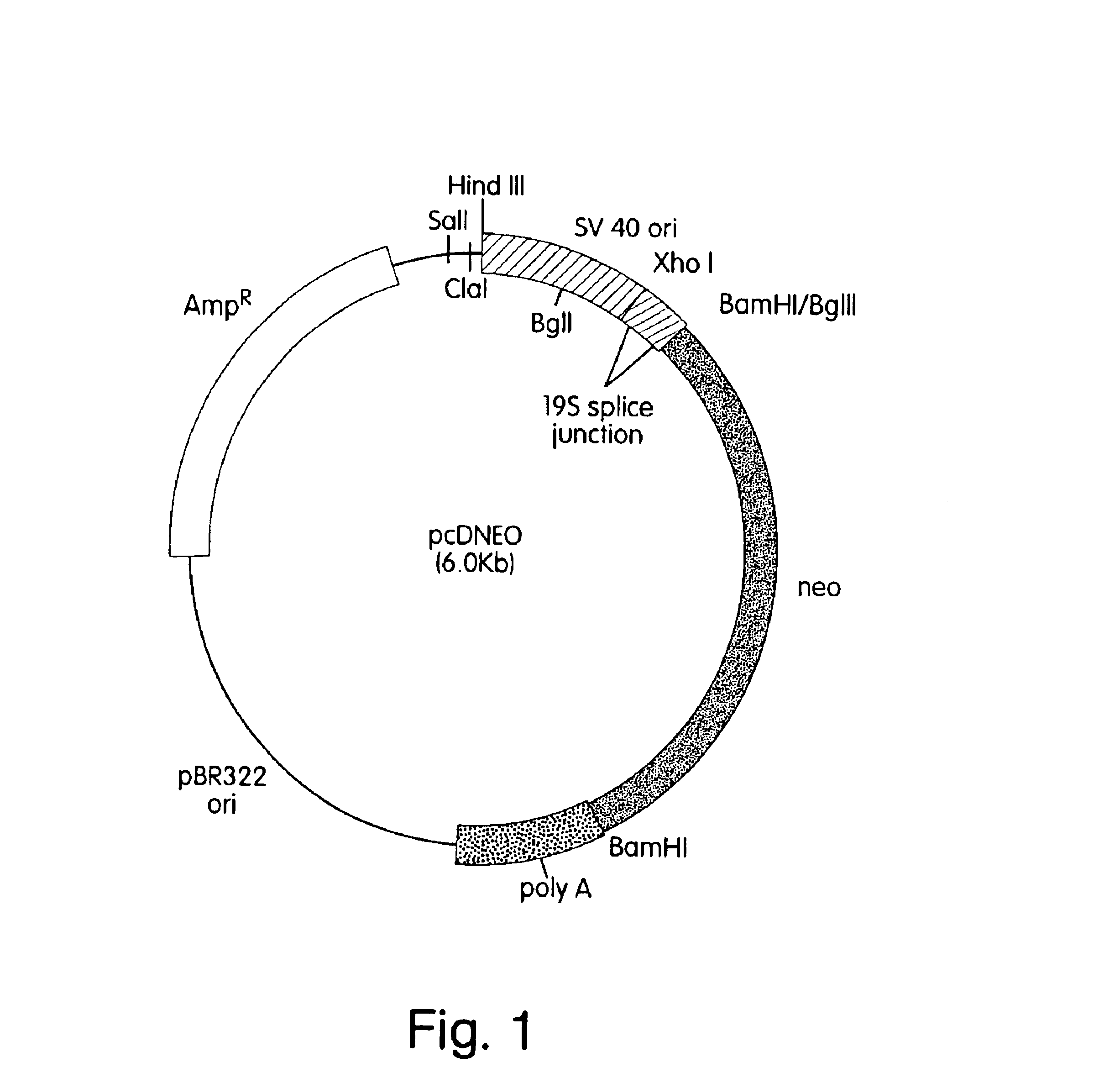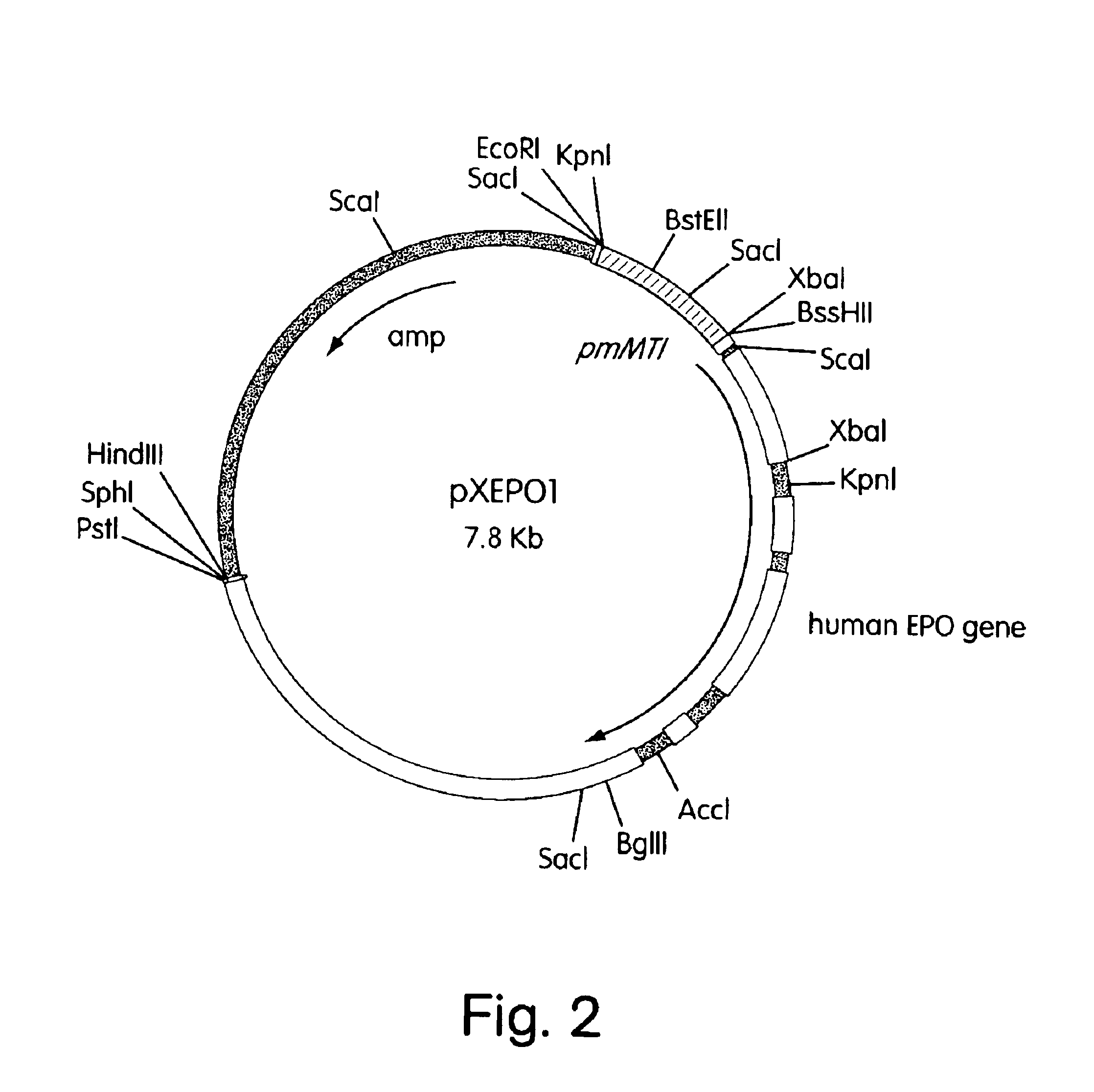In Vivo production and delivery of erythropoietin or insulinotropin for gene therapy
a technology of erythropoietin and gene therapy, which is applied in the field of in vivo production and delivery of erythropoietin or insulinotropin for gene therapy, can solve the problems of decreased epo synthesis, fatigue, weakness, and decreased oxygen-carrying potential, and achieves simple application in treating patients, accurate prediction of long-term function, and reduced treatment costs
- Summary
- Abstract
- Description
- Claims
- Application Information
AI Technical Summary
Benefits of technology
Problems solved by technology
Method used
Image
Examples
example 1
Isolation Of Fibroblasts
[0064]a. Source of Fibroblasts.
[0065]Human fibroblasts can be obtained from a variety of tissues, including biopsy specimens derived from liver, kidney, lung and skin. The procedures presented here are optimized for the isolation of skin fibroblasts, which are readily obtained from individuals of any age with minimal discomfort and risk (embryonic and fetal fibroblasts may be isolated using this protocol as well). Minor modifications to the protocol can be made if the isolation of fibroblasts from other tissues is desired.
[0066]Human skin is obtained following circumcision or punch biopsy. The specimen consists of three major components: the epidermal and dermal layers of the skin itself, and a fascial layer that adheres to the dermal layer. Fibroblasts can be isolated from either the dermal or fascial layers.
[0067]b. Isolation of Human Fascial Fibroblasts.
[0068]Approximately 3 cm2 tissue is placed into approximately 10 ml of wash solution (Hank's Balanced Sa...
example 2
Culturing of Fibroblasts
[0074]a. Culturing of Human Fibroblasts.
[0075]When confluent, the primary culture is trypsinized using standard methods and seeded at approximately 10,000 cells / cm2. The cells are cultured at 37° C. in humidified air containing 5% CO2. Human fibroblast nutrient medium (containing DMEM, high glucose with sodium pyruvate, 10-15% calf serum, 20 mM HEPES, 20 mM L-glutamine, 50 units / ml penicillin G, and 10 μg / ml streptomycin sulfate) is changed twice weekly.
[0076]b. Culturing of Rabbit Fibroblasts.
[0077]The cells are trypsinized and cultured as described for human fibroblasts. Rabbit fibroblast nutrient medium consists of a 1:1 solution of MCDB-110 (Sigma) with 20% calf serum and conditioned medium. Conditioned medium is essentially human fibroblast nutrient medium (with 15% calf serum) removed from rabbit fibroblasts grown in mass culture for 2-3 days.
example 3
Construction of a Plasmid (pXEPO1) Containing the Human Erythropoietin Gene Under the Control of the Mouse Metallothionein Promoter
[0078]The expression plasmid pXEPO1 has the hEPO gene under the transcriptional control of the mouse metallothionein (mMT) promoter. pXEPO1 is constructed as follows: Plasmid pUC19 (ATCC #37254) is digested with KpnI and BamHI and ligated to a 0.7 kb KpnI-BgIII fragment containing the mouse metallothionein promoter [Hamer, D. H. and Walling, M., J. Mol. Appl. Gen., 1:273-288 (1982). This fragment can also be isolated by known methods from mouse genomic DNA using PCR primers designed from analysis of mMT sequences available from Genbank; i.e. MUSMTI, MUSMTIP, MUSMTIPRM]. The resulting clone is designated pXQM2.
[0079]The hEPO gene was isolated by from a bacteriophage lambda clone containing the entire hEPO gene. This bacteriophage was isolated by screening a human Sau3A-partial genomic DNA library (Stratagene) constructed in the lambda vector LAMBDA DASH w...
PUM
| Property | Measurement | Unit |
|---|---|---|
| electroporation voltage | aaaaa | aaaaa |
| electroporation voltage | aaaaa | aaaaa |
| molecular mass | aaaaa | aaaaa |
Abstract
Description
Claims
Application Information
 Login to View More
Login to View More - R&D
- Intellectual Property
- Life Sciences
- Materials
- Tech Scout
- Unparalleled Data Quality
- Higher Quality Content
- 60% Fewer Hallucinations
Browse by: Latest US Patents, China's latest patents, Technical Efficacy Thesaurus, Application Domain, Technology Topic, Popular Technical Reports.
© 2025 PatSnap. All rights reserved.Legal|Privacy policy|Modern Slavery Act Transparency Statement|Sitemap|About US| Contact US: help@patsnap.com



